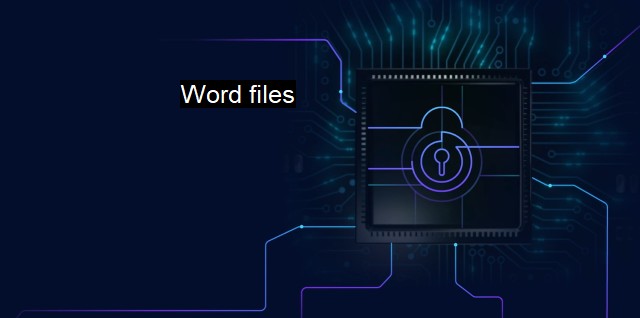What are Word files?
The Importance of Word Files in Cybersecurity: Protecting our Digital Future
In the context of cybersecurity and antivirus protection, "Word files" refer to an extensive variety of document files primarily created, saved, and opened using Microsoft Word, amongst numerous word processing applications available. due to the increasing digitization of work in multiple sectors globally, Microsoft Word has esoterically surfaced as one of the leading word processing systems, thereby expanding the applicability context of "Word files." Consequently, the intensely escalating cyber threat landscape continues to push Microsoft Word-u into the zone of cyber offensive objectives.As a rich vessel of information due to its utility of containing extensive details like personal data, corporate data amongst others, the sensitivity of a "Word file" has escalated multi-fold in the recent few years. These files can be manipulated and maliciously used for ill-meaning purposes if they fall into the wrong hands due to inadequate cybersecurity measures. Increasingly, Word files have become an easy target for hackers who attempt to install malware through the files and breach security protocols.
For instance, attackers can utilize the built-in Visual Basic for Applications (VBA) in Microsoft Word to write their scripts of malicious code, creating what is known as macro malware. Users unknowingly enable this malicious code when they open a word file infected with such malware. The harmful code gets executed, creating a backdoor for hackers to get into the user's system, seize control, or steal crucial data.
Attacks using Word files often employ social engineering tactics in the form of phishing emails to trick unsuspecting users into opening a malicious file. Deceptively authentic looking emails are designed to induce discomfort, urgency, or curiosity, encouraging the recipient to quickly open an attachment without considering the potential for threat. Cybercriminals can also wield exploit kits that can find system vulnerabilities when the Word file is being opened, thus posing another horde of threats.
Heightened cybersecurity measures are in dire need with these e-threats lurking in the background shadows of Word files. Protection against these possible attacks focuses mainly on maintaining an up-to-date antivirus program, typically configured to scan Word files and attachments automatically, thus providing a protective screen against malware.
Despite antivirus programs systematically checking and neutralizing threats, not every threat can be stopped. User awareness and good cyber hygiene are indispensable protective measures as well. Always practicing vigilance against irregularities in emails, particularly those with attachments, is highly advisable. Anything deviating from the usual pathway should be viewed suspiciously and must be prechecked meticulously before you decide to open the email, download, or open the attachment.
Besides, modifying Word settings not to enable macros automatically and updating programs and software regularly can safeguard users from vulnerability exploitation of word files. Nullifying the impact vector for cyber threats and assaults, these update patches are extremely pliant at ensuring potential vulnerabilities and exploits and mitigated, thus providing a secure environment for your word files concurrently.
Decisively, Word files incorporate an intricate measure of confidential information drilled into its DNA that can be easily manipulated in the current digital age. As cyber threats persistently threaten the security and integrity of Word files, users can harness antivirus and be conscious of various precautions to make Word files a steadfast confine instead of a daunting cynosure exposing a system's weakness on the cyberscape.
From social engineering, macro malware to exploit kits, threats around Word files continue to evolve, reflecting a high development cyberspace-tread. Thus, constantly updated antivirus protection, user awareness, and maintaining good cyber hygiene form the spine of safeguarding against these intrusive threats. The contemporary digital dependency merely ups the ante regarding staying alert to cyber threats and implementing stringent cybersecurity measures meticulously for added protection. Hence, the significance of securing Word files is permanently clenched to the gravity of ensuring intellectual property security and the sanctity of data.

Word files FAQs
What is a Word file in the context of cybersecurity?
A Word file is a type of document file created using Microsoft Word that is often used to transmit information electronically. In the context of cybersecurity, Word files may pose a risk if they contain hidden malware or viruses that can infect a computer system.How can Word files be used in a cybersecurity attack?
Hackers can use Word files to deliver malicious code to a user's computer system. The code can be hidden in macros, hyperlinks, or other features of the Word file. When a user opens the file, the code can execute and infect the system with malware or viruses.What can users do to protect themselves from malicious Word files?
Users can protect themselves from malicious Word files by enabling macro security settings and avoiding opening files from unknown or suspicious sources. It is also recommended to keep all software programs, including antivirus software, up-to-date to prevent vulnerabilities that can be exploited by hackers.What antivirus software can help protect against malicious Word files?
Many antivirus software programs can detect and block malicious Word files. Some popular options include Norton, McAfee, and Avast. However, it is important to ensure that the antivirus software is updated regularly and is functioning properly to provide the best protection against Word file attacks.| | A | | | B | | | C | | | D | | | E | | | F | | | G | | | H | | | I | | | J | | | K | | | L | | | M | |
| | N | | | O | | | P | | | Q | | | R | | | S | | | T | | | U | | | V | | | W | | | X | | | Y | | | Z | |
| | 1 | | | 2 | | | 3 | | | 4 | | | 7 | | | 8 | | |||||||